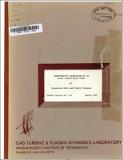Quantitative investigation of inlet vortex flow field
Author(s)
Shin, Hyoun-Woo; Shippee, Cheryl (Cheryl Lynn)
Download16205992.pdf (6.548Mb)
Other Contributors
Massachusetts Institute of Technology. Gas Turbine and Plasma Dynamics Laboratory
Metadata
Show full item recordAbstract
A quantitative investigation of the flow field of an inlet in cross-wind has been carried out for various operating conditions, including flow regimes representative of aircraft engine inlets at take-off. The measurements were made to show the influence of two non-dimensional parameters, height of the inlet above the ground to the inlet diameter ratio (H/D), and velocity ratio (Ui/Ue), on the vortex strength (i.e., circulation) and the position of the vortex inside the inlet. In general, as H/D is decreased and/or Ui/Ue is increased, the vortex strengthens. In addition, at an operating condition where a strong inlet vortex was present, the circulation of both the inlet and trailing vortices was determined. These were found to be essentially equal in magnitude but opposite in sign, verifying a previous hypothesis concerning the vortical structure of the flow. Qualitative flow visualization has been done to examine two aspects of the inlet/trailing vortex flow field. One is the nature of the transition between regimes in which an inlet vortex is present and those in which no inlet vortex exists. The other deals with the extent of the separated region on the inlet body. The results of this study were used to support a conceptual model of the formation of an inlet/trailing vortex system for an inlet in a cross-wind.
Description
March 1984 Includes bibliographical references (leaf 126)
Date issued
1984Publisher
Cambridge, Mass. : Gas Turbine & Plasma Dynamics Laboratory, Massachusetts Institute of Technology, [1984]
Series/Report no.
GT & PDL report ; no. 179